
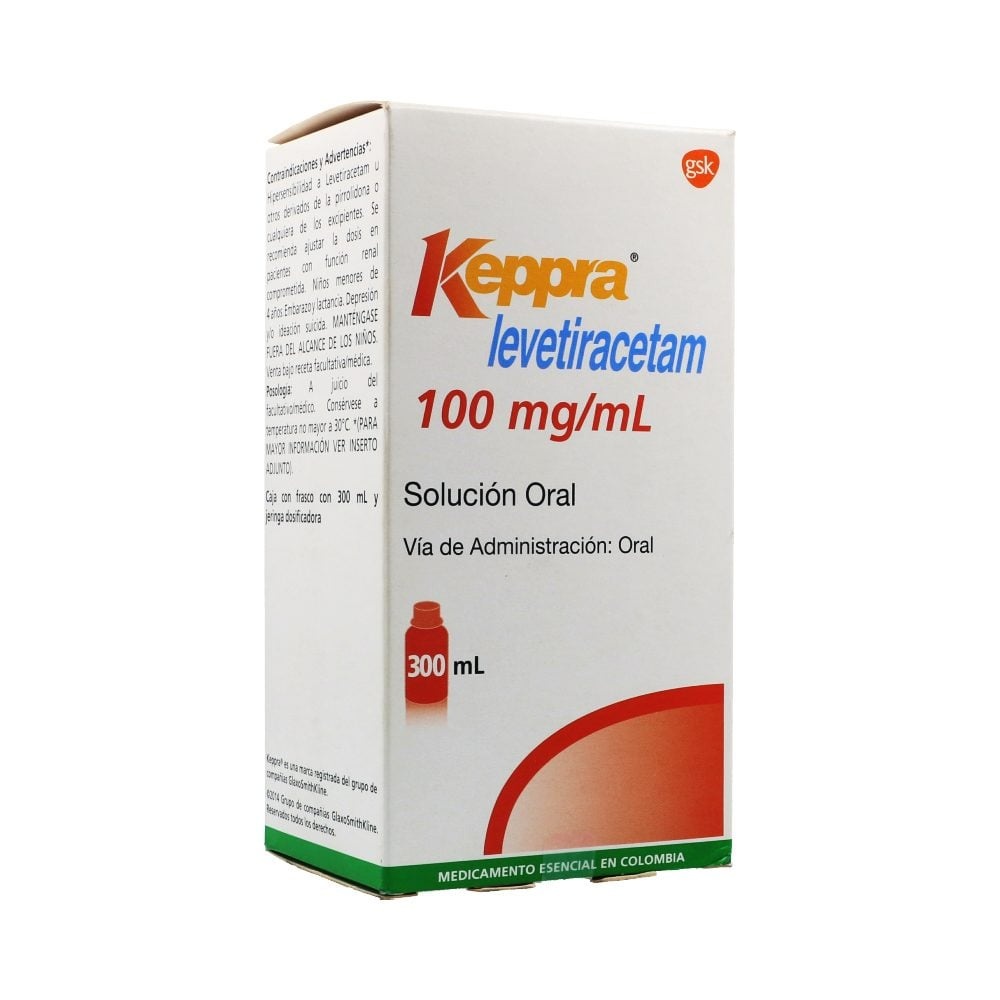
KEPPRA 100 mg/ml ORAL SOLUTION

Ask a doctor about a prescription for KEPPRA 100 mg/ml ORAL SOLUTION

How to use KEPPRA 100 mg/ml ORAL SOLUTION
Introduction
Package Leaflet: Information for the Patient
Keppra 100 mg/ml Oral Solution
Levetiracetam
Read all of this leaflet carefully before you or your child start taking this medicine because it contains important information for you.
- Keep this leaflet as you may need to read it again.
- If you have any further questions, ask your doctor or pharmacist.
- This medicine has been prescribed for you only. Do not pass it on to others. It may harm them, even if their signs of illness are the same as yours.
- If you get any side effects, talk to your doctor or pharmacist. This includes any possible side effects not listed in this leaflet. See section 4.
Contents of the Package Leaflet
- What is Keppra and what is it used for
- What you need to know before you take Keppra
- How to take Keppra
- Possible side effects
- Storing Keppra
- Contents of the pack and other information
1. What is Keppra and what is it used for
Levetiracetam is an antiepileptic medicine (a medicine used to treat seizures in epilepsy).
Keppra is used:
- on its own in adults and adolescents from 16 years of age with newly diagnosed epilepsy to treat a certain form of epilepsy. Epilepsy is a condition where patients have seizures. Levetiracetam is used to reduce the number of seizures.
- with other antiepileptic medicines to treat:
- partial onset seizures with or without generalisation in adults, adolescents, children and infants from 1 month of age.
- myoclonic seizures (short, shock-like jerks of a muscle or a group of muscles) in adults and adolescents from 12 years of age with juvenile myoclonic epilepsy.
- primary generalised tonic-clonic seizures (major seizures, including loss of consciousness) in adults and adolescents from 12 years of age with idiopathic generalised epilepsy (a type of epilepsy that is thought to have a genetic cause).
2. What you need to know before you take Keppra
Do not take Keppra
- If you are allergic to levetiracetam, to any other pyrrolidone derivative or to any of the other ingredients of this medicine (listed in section 6).
Warnings and precautions
Tell your doctor before you start taking Keppra
- If you have kidney problems, follow your doctor's instructions, as they will decide if you need a dose adjustment.
- If you notice any decrease in your child's growth or an unexpected delay in puberty, contact your doctor.
- A small number of people taking antiepileptics such as Keppra have had thoughts of harming themselves or committing suicide. If you have any symptoms of depression and/or suicidal thoughts, contact your doctor.
- If you have a medical history or a family history of irregular heartbeats or if you have a condition or are taking a treatment that may lead to irregular heartbeats or electrolyte imbalance.
Tell your doctor or pharmacist if any of the following side effects get worse or last more than a few days:
- Abnormal thoughts, feeling irritable or behaving more aggressively than usual, or if you, your family or friends notice significant changes in mood or behaviour.
- Worsening of epilepsy:
In rare cases, the seizures may become worse or more frequent, mainly during the first month after starting treatment or after increasing the dose.
In a very rare form of early onset epilepsy (epilepsy associated with SCN8A mutations) that causes multiple types of seizures and loss of skills, you may notice that the seizures persist or worsen during treatment.
If you experience any of these new symptoms while taking Keppra, see a doctor as soon as possible.
Children and adolescents
- Monotherapy with Keppra (single treatment) is not indicated in children and adolescents under 16 years.
Using Keppra with other medicines
Tell your doctor or pharmacist if you are taking, have recently taken or might take any other medicines.
Do not take macrogol (a laxative medicine) for one hour before and one hour after taking levetiracetam, as it may reduce its effect.
Pregnancy and breastfeeding
If you are pregnant or breastfeeding, think you may be pregnant or are planning to have a baby, ask your doctor for advice before taking this medicine. Levetiracetam should only be used during pregnancy if, after careful evaluation, your doctor considers it necessary.
Do not stop your treatment without discussing it with your doctor.
The risk of birth defects for your baby cannot be completely ruled out.
Breastfeeding is not recommended during treatment with Keppra.
Driving and using machines
Keppra may affect your ability to drive or use tools or machines, as it may cause drowsiness. This is more likely at the start of treatment or when the dose is increased. You should not drive or use machines until it is established that your ability to perform these activities is not affected.
Keppra contains methyl parahydroxybenzoate, propyl parahydroxybenzoate and maltitol
Keppra 100 mg/ml oral solution, which contains methyl parahydroxybenzoate (E218) and propyl parahydroxybenzoate (E216), may cause allergic reactions (which may be delayed).
Keppra oral solution also contains maltitol. If your doctor tells you that you have an intolerance to some sugars, contact your doctor before taking this medicine.
Keppra contains sodium
This medicine contains less than 1 mmol sodium (23 mg) per ml, i.e., essentially “sodium-free”.
3. How to take Keppra
Follow exactly the instructions given to you by your doctor or pharmacist. If you are not sure, ask your doctor or pharmacist.
Take Keppra twice daily, once in the morning and once in the evening, approximately at the same time each day.
Take the oral solution as instructed by your doctor.
Monotherapy (from 16 years of age)
Adults (≥18 years) and adolescents (from 16 years of age):
For patients from 4 years of age, measure the correct dose using the 10 ml syringe provided in the box.
Recommended dose: Keppra is taken twice daily, in two equal doses, each individual dose between 5 ml (500 mg) and 15 ml (1,500 mg).
When starting Keppra, your doctor will prescribe a lower dosefor two weeks before giving you the lowest daily dose.
Concomitant therapy
Dose in adults and adolescents (from 12 to 17 years):
For patients from 4 years of age, measure the correct dose using the 10 ml syringe provided in the box.
Recommended dose: Keppra is taken twice daily, in two equal doses, each individual dose between 5 ml (500 mg) and 15 ml (1,500 mg).
Dose in children from 6 months of age:
Your doctor will prescribe the most suitable pharmaceutical form of Keppra according to the age, weight and dose.
For children from 6 months to 4 years of age, measure the correct dose using the 3 mlsyringe provided in the box.
For children over 4 years of age, measure the correct dose using the 10 mlsyringe provided in the box.
Recommended dose: Keppra is taken twice daily, in two equal doses, each individual dose between 0.1 ml (10 mg) and 0.3 ml (30 mg) per kg of the child's body weight (see the following table for examples of doses).
Dose in children from 6 months of age:
Weight | Initial dose: 0.1 ml/kg twice daily | Maximum dose: 0.3 ml/kg twice daily |
6 kg | 0.6 ml twice daily | 1.8 ml twice daily |
8 kg | 0.8 ml twice daily | 2.4 ml twice daily |
10 kg | 1 ml twice daily | 3 ml twice daily |
15 kg | 1.5 ml twice daily | 4.5 ml twice daily |
20 kg | 2 ml twice daily | 6 ml twice daily |
25 kg | 2.5 ml twice daily | 7.5 ml twice daily |
From 50 kg | 5 ml twice daily | 15 ml twice daily |
Dosing in infants (from 1 month to less than 6 months):
For infants from 1 month to less than 6 months of age, measure the correct dose using the 1 mlsyringe provided in the box.
Recommended dose: Keppra is taken twice daily, in two equal doses, each individual dose between 0.07 ml (7 mg) and 0.21 ml (21 mg) per kg of the infant's body weight (see the following table for examples of doses).
Dose in infants (from 1 month to less than 6 months of age):
Weight | Initial dose: 0.07 ml/kg twice daily | Maximum dose: 0.21 ml/kg twice daily |
4 kg | 0.3 ml twice daily | 0.85 ml twice daily |
5 kg | 0.35 ml twice daily | 1.05 ml twice daily |
6 kg | 0.45 ml twice daily | 1.25 ml twice daily |
7 kg | 0.5 ml twice daily | 1.5 ml twice daily |
Method of administration:
After measuring the correct dose with the suitable syringe, Keppra oral solution can be diluted in a glass of water or in a baby bottle. You can take Keppra with or without food. After oral administration of levetiracetam, a bitter taste may be noticed.
Instructions on how to use the syringe:
- Open the bottle: press the cap and unscrew in the opposite direction of the clock hands (figure 1)

- Follow these steps the first time you take Keppra:
- Separate the adapter from the oral syringe (figure 2).
- Place the adapter on the top of the bottle (figure 3). Make sure it is well fixed in place. You do not need to remove the adapter after use.
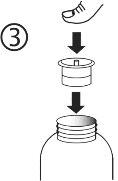
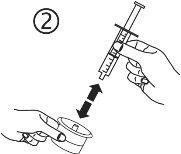
- Follow these steps each time you take Keppra:
- Place the oral syringe in the adapter opening (figure 4).
- Hold the bottle upside down (figure 5).
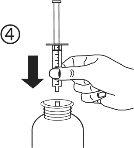
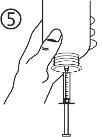
- Hold the bottle upside down with one hand and use the other hand to fill the oral syringe.
- Pull the plunger down to fill the oral syringe with a small amount of solution (figure 5A).
- Then, push the plunger up to eliminate any possible air bubbles (figure 5B).
- Lower the plunger to the graduation mark on the oral syringe that corresponds to the dose in milliliters (ml) prescribed by your doctor (figure 5C). The plunger may go back up the cylinder with the first administration. Therefore, make sure the plunger is in position until the syringe is disconnected from the bottle.


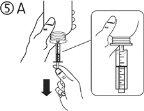
- Hold the bottle upright (figure 6A). Remove the syringe from the adapter (figure 6B).
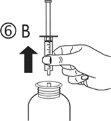

- Empty the contents of the syringe into a glass of water or a baby bottle, pushing the plunger to the end of the syringe (figure 7).

|
|
| |
| |
|
Duration of treatment:
- Keppra is used as a chronic treatment. You should continue treatment with Keppra for the time indicated by your doctor.
- Do not stop your treatment without your doctor's advice, as your seizures may increase.
If you take more Keppra than you should
Possible side effects of an overdose of Keppra are drowsiness, agitation, aggression, decreased alertness, inhibition of breathing, and coma.
Contact your doctor if you have taken more oral solution than you should. Your doctor will establish the best possible treatment for the overdose.
If you forget to take Keppra:
Contact your doctor if you have missed one or more doses.
Do not take a double dose to make up for missed doses.
If you stop treatment with Keppra:
Stopping treatment with Keppra should be done gradually to avoid an increase in seizures. If your doctor decides to stop your treatment with Keppra, they will give you instructions for gradual withdrawal of Keppra.
If you have any other questions about the use of this medicine, ask your doctor or pharmacist.
4. Possible Adverse Effects
Like all medicines, Keppra can cause adverse effects, although not all people suffer from them.
Tell your doctor immediately, or go to the emergency department of your nearest hospital if you experience:
- weakness, dizziness, or difficulty breathing, as these may be signs of a severe allergic reaction (anaphylaxis)
- swelling of the face, lips, tongue, or throat (Quincke's edema)
- flu-like symptoms and rash on the face followed by a prolonged rash with high temperature, elevated liver enzyme levels in blood tests, and an increase in a type of white blood cells (eosinophilia), enlarged lymph nodes, and the involvement of other body organs (Drug Hypersensitivity Reaction with Eosinophilia and Systemic Symptoms (DRESS))
- symptoms such as low urine output, fatigue, nausea, vomiting, confusion, and swelling of legs, arms, or feet, as these may be signs of sudden renal function decrease
- a skin rash that can form blisters and may appear as small targets (dark central spots surrounded by a paler area, with a dark ring around the edge) (erythema multiforme)
- a widespread rash with blisters and skin peeling, especially around the mouth, nose, eyes, and genitals (Stevens-Johnson syndrome)
- a more severe form that causes skin peeling on more than 30% of the body surface (toxic epidermal necrolysis)
- signs of severe mental changes or if someone around you notices signs of confusion, drowsiness (drowsiness), amnesia (memory loss), memory impairment (forgetfulness), abnormal behavior, or other neurological signs, including involuntary or uncontrolled movements. These may be symptoms of encephalopathy.
The most frequently reported adverse effects are nasopharyngitis, drowsiness (feeling of sleep), headache, fatigue, and dizziness. Adverse effects such as drowsiness, weakness, and dizziness may be more frequent when treatment is initiated or the dose is increased. However, these adverse effects should decrease over time.
Very Common: may affect more than 1 in 10 people
- nasopharyngitis;
- drowsiness (feeling of sleep), headache.
Common: may affect up to 1 in 10 people
- anorexia (loss of appetite);
- depression, hostility, or aggression, anxiety, insomnia, nervousness, or irritability;
- seizures, balance disorder, dizziness (feeling of instability), lethargy (lack of energy and enthusiasm), tremor (involuntary tremor);
- vertigo (feeling of rotation);
- cough;
- abdominal pain, diarrhea, dyspepsia (heavy digestion, heartburn, and acidity), vomiting, nausea;
- skin rash;
- asthenia/fatigue (feeling of weakness).
Uncommon: may affect up to 1 in 100 people
- decrease in platelet count, decrease in white blood cells;
- weight loss, weight gain;
- suicidal thoughts and behaviors, mental disorders, abnormal behavior, hallucinations, anger, confusion, panic attack, emotional instability/mood changes, agitation;
- amnesia (memory loss), memory impairment (lack of memory), abnormal coordination/ataxia (altered movement coordination), paresthesia (tingling), attention disorders (loss of concentration);
- diplopia (double vision), blurred vision;
- elevated/abnormal liver function test values;
- hair loss, eczema, itching;
- muscle weakness, myalgia (muscle pain);
- injury.
Rare: may affect up to 1 in 1,000 people
- infection;
- decrease in all types of blood cells;
- severe allergic reactions (DRESS, anaphylactic reaction (severe and serious allergic reaction), Quincke's edema (swelling of the face, lips, tongue, and throat));
- decrease in blood sodium concentration;
- suicide, personality disorders (behavioral problems), abnormal thinking (slow thinking, difficulty concentrating);
- delirium;
- encephalopathy (see subsection "Tell your doctor immediately" for a detailed description of symptoms);
- epileptic seizures may worsen or occur more frequently;
- uncontrolled muscle spasms affecting the head, torso, and limbs, difficulty controlling movements, hyperkinesia (hyperactivity);
- change in heart rhythm (electrocardiogram);
- pancreatitis (inflammation of the pancreas);
- liver failure, hepatitis (inflammation of the liver);
- sudden decrease in renal function;
- skin rash, which may lead to blisters that may appear as small targets (dark central spots surrounded by a paler area, with a dark ring around the edge) (erythema multiforme), a widespread rash with blisters and skin peeling, especially around the mouth, nose, eyes, and genitals (Stevens-Johnson syndrome), and a more severe form that causes skin peeling on more than 30% of the body surface (toxic epidermal necrolysis):
- rhabdomyolysis (muscle tissue breakdown) and increased blood creatine phosphokinase associated. The prevalence is significantly higher in Japanese patients compared to non-Japanese patients;
- limping or difficulty walking;
- a combination of fever, muscle stiffness, unstable blood pressure and heart rate, confusion, low level of consciousness (may be signs of a disorder called malignant neuroleptic syndrome). The prevalence is significantly higher in Japanese patients compared to non-Japanese patients.
Very Rare: may affect up to 1 in 10,000 people
- unwanted and repetitive thoughts or feelings or the urge to do something over and over again (obsessive-compulsive disorder).
Reporting Adverse Effects
If you experience any type of adverse effect, consult your doctor or pharmacist, even if it is a possible adverse effect that is not listed in this prospectus. You can also report them directly through the national reporting system included in Appendix V. By reporting adverse effects, you can contribute to providing more information on the safety of this medicine.
5. Storage of Keppra
Keep this medicine out of sight and reach of children.
Do not use this medicine after the expiration date stated on the carton and on the bottle after CAD.
The expiration date is the last day of the month indicated.
Do not use after 7 months of opening the package.
Store in the original bottle, to protect it from light.
Medicines should not be disposed of via wastewater or household waste. Ask your pharmacist how to dispose of the packaging and medicines that are no longer needed. This will help protect the environment.
6. Package Contents and Additional Information
Composition of Keppra
The active ingredient is levetiracetam. Each ml contains 100 mg of levetiracetam.
The other ingredients are: sodium citrate, citric acid monohydrate, methyl parahydroxybenzoate (E218), propyl parahydroxybenzoate (E216), ammonium glycyrrhizate, glycerol (E422), liquid maltitol (E965), acesulfame potassium (E950), grape flavor, purified water.
Appearance and Package Contents of the Product
Keppra 100 mg/ml oral solution is a clear liquid.
The 300 ml glass bottle of Keppra (for children from 4 years of age, adolescents, and adults) is packaged in a cardboard box with a 10 ml oral syringe (graduated every 0.25 ml) and a syringe adapter.
The 150 ml glass bottle of Keppra (for infants and young children from 6 months to less than 4 years of age) is packaged in a cardboard box with a 5 ml oral syringe (graduated every 0.1 ml from 0.3 ml to 5 ml and every 0.25 ml from 0.25 ml to 5 ml) and a syringe adapter.
The 150 ml glass bottle of Keppra (for infants from 1 month to less than 6 months of age) is packaged in a cardboard box with a 1 ml oral syringe (graduated every 0.05 ml) and a syringe adapter.
Marketing Authorization Holder
UCB Pharma SA, Allée de la Recherche 60, B-1070 Brussels, Belgium.
Manufacturer
NextPharma SAS, 17 Route de Meulan, F-78520 Limay, France
or UCB Pharma SA, Chemin du Foriest, B-1420 Braine-l’Alleud, Belgium
You can request more information about this medicine by contacting the local representative of the marketing authorization holder.
België/Belgique/Belgien UCB Pharma SA/NV Tel/Tél: + 32 / (0)2 559 92 00 | Lietuva UAB Medfiles Tel: +370 5 246 16 40 |
| Luxembourg/Luxemburg UCB Pharma SA/NV Tél/Tel: + 32 / (0)2 559 92 00 |
Česká republika UCB s.r.o. Tel: + 420 221 773 411 | Magyarország UCB Magyarország Kft. Tel.: + 36-(1) 391 0060 |
Danmark UCB Nordic A/S Tlf.: + 45 / 32 46 24 00 | Malta Pharmasud Ltd. Tel: + 356 / 21 37 64 36 |
Deutschland UCB Pharma GmbH Tel: + 49 /(0) 2173 48 4848 | Nederland UCB Pharma B.V. Tel: + 31 / (0)76-573 11 40 |
Eesti OÜ Medfiles Tel: +372 730 5415 | Norge UCB Nordic A/S Tlf: + 45 / 32 46 24 00 |
Ελλάδα UCB Α.Ε. Τηλ: + 30 / 2109974000 | Österreich UCB Pharma GmbH Tel: + 43 (0)1 291 80 00 |
España UCB Pharma, S.A. Tel: + 34 / 91 570 34 44 | Polska UCB Pharma Sp. z o.o. Tel.: + 48 22 696 99 20 |
France UCB Pharma S.A. Tél: + 33 / (0)1 47 29 44 35 | Portugal UCB Pharma (Produtos Farmacêuticos), Lda. Tel: + 351 / 21 302 5300 |
Hrvatska Medis Adria d.o.o. Tel: +385 (0) 1 230 34 46 | România UCB Pharma România S.R.L. Tel: + 40 21 300 29 04 |
Ireland UCB (Pharma) Ireland Ltd. Tel: + 353 / (0)1-46 37 395 | Slovenija Medis, d.o.o. Tel: + 386 1 589 69 00 |
Ísland UCB Nordic A/S Sími: + 45 / 32 46 24 00 | Slovenská republika UCB s.r.o., organizačná zložka Tel: + 421 (0) 2 5920 2020 |
Italia UCB Pharma S.p.A. Tel: + 39 / 02 300 791 | Suomi/Finland UCB Pharma Oy Finland Puh/Tel: +358 9 2514 4221 |
Κύπρος Lifepharma (Z.A.M.) Ltd Τηλ: + 357 22 34 74 40 | Sverige UCB Nordic A/S Tel: + 46 / (0) 40 29 49 00 |
Latvija Medfiles SIA Tel: +371 67 370 250 |
Date of Last Revision of this Prospectus:
Other Sources of Information
Detailed information about this medicine is available on the European Medicines Agency website: https://www.ema.europa.eu.

How much does KEPPRA 100 mg/ml ORAL SOLUTION cost in Spain ( 2025)?
The average price of KEPPRA 100 mg/ml ORAL SOLUTION in December, 2025 is around 56.64 EUR. Prices may vary depending on the region, pharmacy, and whether a prescription is required. Always check with a local pharmacy or online source for the most accurate information.
- Country of registration
- Average pharmacy price56.64 EUR
- Active substance
- Prescription requiredYes
- Manufacturer
- This information is for reference only and does not constitute medical advice. Always consult a licensed doctor before taking any medication. Oladoctor is not responsible for medical decisions based on this content.
- Alternatives to KEPPRA 100 mg/ml ORAL SOLUTIONDosage form: INJECTABLE PERFUSION, 100 mgActive substance: levetiracetamManufacturer: Ucb PharmaPrescription requiredDosage form: INJECTABLE PERFUSION, 100 mg/mlActive substance: levetiracetamManufacturer: Ucb PharmaPrescription requiredDosage form: ORAL SOLUTION/SUSPENSION, 100 mg/ml of LevetiracetamActive substance: levetiracetamManufacturer: Ucb PharmaPrescription required
Alternatives to KEPPRA 100 mg/ml ORAL SOLUTION in other countries
The best alternatives with the same active ingredient and therapeutic effect.
Alternative to KEPPRA 100 mg/ml ORAL SOLUTION in Poland
Alternative to KEPPRA 100 mg/ml ORAL SOLUTION in Ukraine
Online doctors for KEPPRA 100 mg/ml ORAL SOLUTION
Discuss dosage, side effects, interactions, contraindications, and prescription renewal for KEPPRA 100 mg/ml ORAL SOLUTION – subject to medical assessment and local rules.









